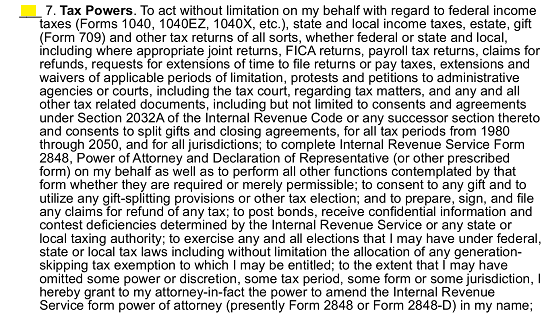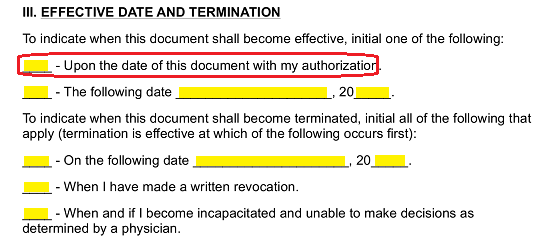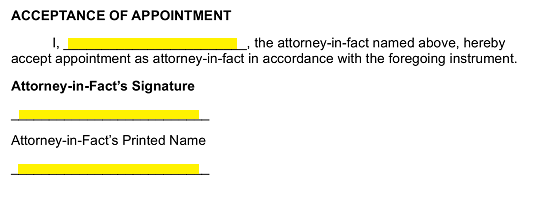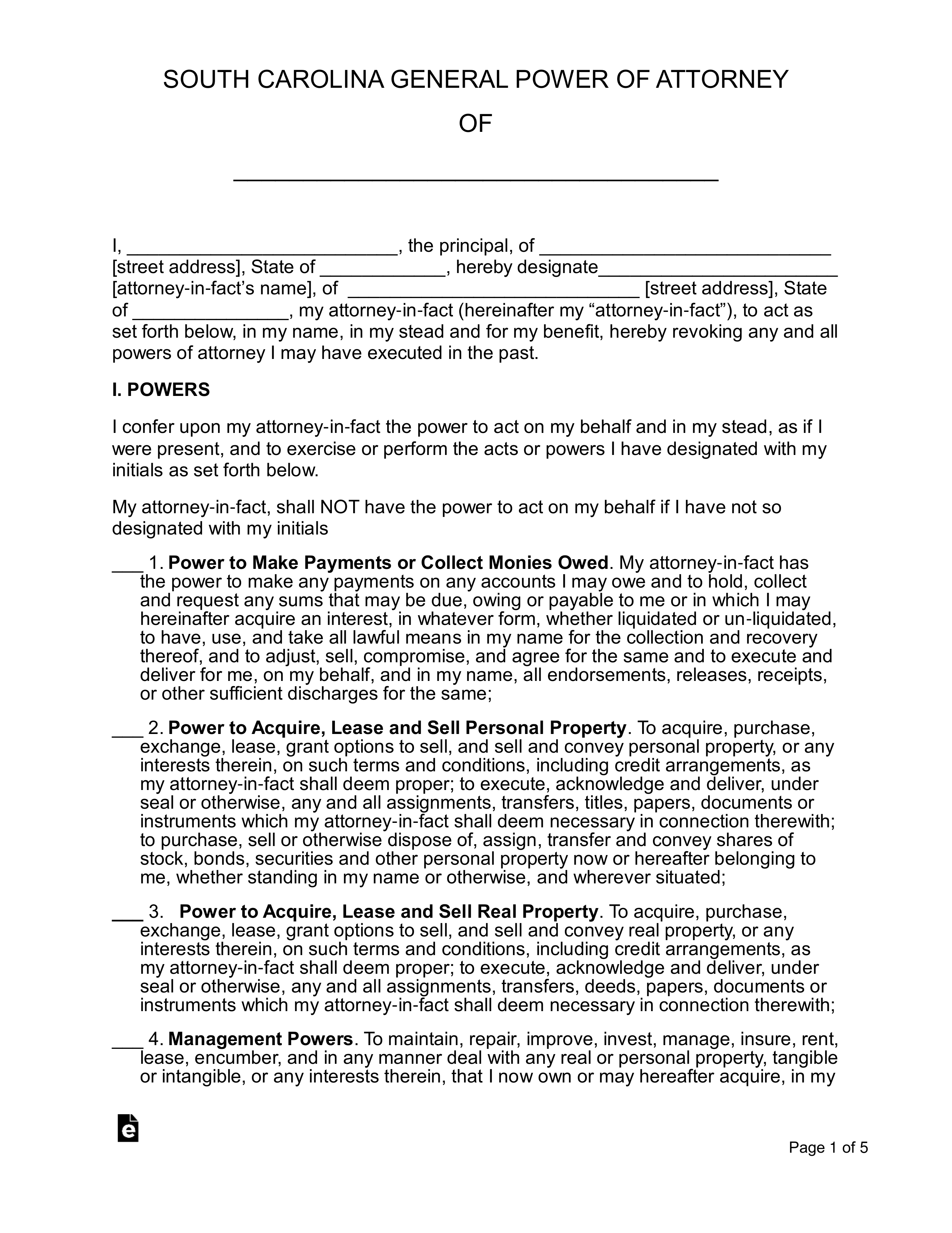Updated August 09, 2023
A South Carolina General (Financial) Power of Attorney Form provides a person to grant the power to act on their behalf in broad financial matters to another party. This Agent can act with Powers similar to those delivered through a durable power document. However, it will automatically terminate when the Principal (the person who granted the power to another) is deemed unable to continue to make his or her decisions or loses the ability to communicate effectively to those around him or her. If your intent is to deliver Principal Powers that stay in effect despite being incapacitated, then you may wish to issue a Durable Power of Attorney. In either case, make sure to select a trustworthy and reliable Agent to represent you in the matters you define. You can also download the durable form instead.
Laws
- Statutes – South Carolina Uniform Power of Attorney Act
- Authority (S.C. Code § 62-8-201) – An agent under a power of attorney may act on behalf of the principal and exercise broad authority as granted by the agreement.
- Signing Requirements (S.C. Code § 62-8-105) – Two (2) Witnesses and Notary Public.
How to Write
Download: PDF, MS Word, OpenDocument
1 – Supplement The Title And Introduction With The Requested Identity Information
This paperwork will fulfill its purpose but will require that information specific to the situation be presented in some blank lines, beginning with the Title. Use the blank line in the Title to document the Principal’s Legal Name. This is the individual granting Principal Power by executing this document through his or her Signature.  The paragraph directly beneath the Title will have a few areas that require information. We will be focusing on the Principal in the first three spaces. Utilize the first available space to enter the Full Name of the Principal exactly as it was recorded in the Title.
The paragraph directly beneath the Title will have a few areas that require information. We will be focusing on the Principal in the first three spaces. Utilize the first available space to enter the Full Name of the Principal exactly as it was recorded in the Title.  Then, on the second and third blank lines will accept the Principal’s Residential Street Address and the State where he or she lives.
Then, on the second and third blank lines will accept the Principal’s Residential Street Address and the State where he or she lives.  Next, the Attorney-in-Fact’s Legal Name and Residence should be reported. His or her Name should be recorded on the first blank line. Then, in a similar manner as the Principal’s Report, enter the Attorney-in-Fact’s Residential Address and State of Residence on the next two blank lines.
Next, the Attorney-in-Fact’s Legal Name and Residence should be reported. His or her Name should be recorded on the first blank line. Then, in a similar manner as the Principal’s Report, enter the Attorney-in-Fact’s Residential Address and State of Residence on the next two blank lines.
2 – The Principal Powers Delivered Require Principal Attention
The next part of this document is titled “Powers.” Simply put, this will be where the Principal decides what Principal Powers should be assigned to the Attorney-in-Fact. The Principal should review the numbered items in this section, then initial each one that should be included in the Principal Powers delivered to the Attorney-in-Fact.
If the Principal initials the blank space that precedes the paragraph label “1. Power To Make Payments Or Collect Monies Owed,” he or she will grant the Attorney-in-Fact the right to behave in the manner defined. For example, the Attorney-in-Fact will be able to pay a Principal Debt as the Principal using whatever Principal assets/money/property available according to this paragraph.  The Attorney-in-Fact will have the Principal’s “Power To Acquire, Lease And Sell Personal Property” and can wield such Power under the direction of the second list item. The Principal will need to provide his or her initials to the blank space presented to give the Attorney-in-Fact the necessary approval to engage in any of the actions described here.
The Attorney-in-Fact will have the Principal’s “Power To Acquire, Lease And Sell Personal Property” and can wield such Power under the direction of the second list item. The Principal will need to provide his or her initials to the blank space presented to give the Attorney-in-Fact the necessary approval to engage in any of the actions described here.  The Principal can use the wording in “3. Power To Acquire, Lease And Sell Real Property” to deliver the Principal Power the Attorney-in-Fact needs to deal with the Principal’s Real Property with the same Authority the Principal has over that Property by initialing the blank line that precedes the number “3.”
The Principal can use the wording in “3. Power To Acquire, Lease And Sell Real Property” to deliver the Principal Power the Attorney-in-Fact needs to deal with the Principal’s Real Property with the same Authority the Principal has over that Property by initialing the blank line that precedes the number “3.” The language in the fourth item will describe how the Attorney-in-Fact can Manage Principal Property (tangible or intangible) using Principal Authority. If the Principal has decided to grant this Power he or she must initial “4. Management Powers” to do so.
The language in the fourth item will describe how the Attorney-in-Fact can Manage Principal Property (tangible or intangible) using Principal Authority. If the Principal has decided to grant this Power he or she must initial “4. Management Powers” to do so.  If the Principal intends for the Attorney-in-Fact to execute Principal Decisions and Actions in Banking with Financial Institutions on his or her behalf, then “5. Banking Powers” must be initialed by the Principal.
If the Principal intends for the Attorney-in-Fact to execute Principal Decisions and Actions in Banking with Financial Institutions on his or her behalf, then “5. Banking Powers” must be initialed by the Principal.  The Attorney-in-Fact will have the Principal Right to conduct affairs with the Principal’s Vehicles with the same Authority as the Principal when the Principal initials “6. Motor Vehicles.”
The Attorney-in-Fact will have the Principal Right to conduct affairs with the Principal’s Vehicles with the same Authority as the Principal when the Principal initials “6. Motor Vehicles.” The Principal can appoint the Attorney-in-Fact with the ability and Authority to exercise the Principal’s interest over his or her Tax Affairs by initialing “7. Tax Powers.”
The Principal can appoint the Attorney-in-Fact with the ability and Authority to exercise the Principal’s interest over his or her Tax Affairs by initialing “7. Tax Powers.” In “8. Safe-Deposit Boxes,” the Principal can grant the Authority required so the Agent can access and control Principal Safe-Deposit Boxes. He or she only needs to initial the blank line that precedes this paragraph’s label to approve the Attorney-in-Fact’s right to perform the actions defined here.
In “8. Safe-Deposit Boxes,” the Principal can grant the Authority required so the Agent can access and control Principal Safe-Deposit Boxes. He or she only needs to initial the blank line that precedes this paragraph’s label to approve the Attorney-in-Fact’s right to perform the actions defined here.  If the Principal has determined the Attorney-in-Fact should possess the same “Gift Making Powers” he or she does, the blank line just before the number 9 will need to bear Principal Initials so these Powers may be granted.
If the Principal has determined the Attorney-in-Fact should possess the same “Gift Making Powers” he or she does, the blank line just before the number 9 will need to bear Principal Initials so these Powers may be granted.  The Attorney-in-Fact will have the Principal “Lending And Borrowing” Powers once the Principal initials the tenth paragraph.
The Attorney-in-Fact will have the Principal “Lending And Borrowing” Powers once the Principal initials the tenth paragraph.  The wording in “11. Contracts” will give the Attorney-in-Fact the Principal Powers to handle contractual affairs on behalf of the Principal. To grant such Power to the Attorney-in-Fact, the Principal must initial this item.
The wording in “11. Contracts” will give the Attorney-in-Fact the Principal Powers to handle contractual affairs on behalf of the Principal. To grant such Power to the Attorney-in-Fact, the Principal must initial this item. ![]() To grant the Attorney-in-Fact the Principal Power to make Health Care Arrangements (and all actions such arrangements entail) to satisfy the Principal’s Medical needs, the Principal must initial “12. Health Care.”
To grant the Attorney-in-Fact the Principal Power to make Health Care Arrangements (and all actions such arrangements entail) to satisfy the Principal’s Medical needs, the Principal must initial “12. Health Care.” The Principal Power to represent the Principal under the Health Insurance Portability And Accountability Act Of 1996 can be appointed to the Attorney-in-Fact through the Principal’s initials on “13. HIPPA.”
The Principal Power to represent the Principal under the Health Insurance Portability And Accountability Act Of 1996 can be appointed to the Attorney-in-Fact through the Principal’s initials on “13. HIPPA.” The Authorization to wield the Principal “Power To Hire And Pay For Services” can be granted to the Attorney-in-Fact through Principal’s Initials presented on the blank line that precedes the number 14.
The Authorization to wield the Principal “Power To Hire And Pay For Services” can be granted to the Attorney-in-Fact through Principal’s Initials presented on the blank line that precedes the number 14.  The Attorney-in-Fact can be given the right to act as the Principal in delivering Reimbursements to cover reasonable costs the Attorney-in-Fact is responsible for when carrying out Principal Directives. To delegate this Authority, the Principal must initial “15. Reimbursement Of Attorney-in-Fact.”
The Attorney-in-Fact can be given the right to act as the Principal in delivering Reimbursements to cover reasonable costs the Attorney-in-Fact is responsible for when carrying out Principal Directives. To delegate this Authority, the Principal must initial “15. Reimbursement Of Attorney-in-Fact.”![]() The Principal can give the Attorney-in-Fact the Right and “Power To Sue Third Parties Who Fail To Act Pursuant To Power Of Attorney” on his or her behalf by initialing the empty line just before the number 16.
The Principal can give the Attorney-in-Fact the Right and “Power To Sue Third Parties Who Fail To Act Pursuant To Power Of Attorney” on his or her behalf by initialing the empty line just before the number 16.  In the event the Principal has additional directives the Attorney-in-Fact should have the Power to carry out, they may be recorded in “17. Other.” This is handy since the Principal may wish to grant a very specific power to the Attorney-in-Fact that was not granted through the completion of this list. Naturally, the Principal will have to initial the blank line for “17. Other – Power To Conduct The Following.”
In the event the Principal has additional directives the Attorney-in-Fact should have the Power to carry out, they may be recorded in “17. Other.” This is handy since the Principal may wish to grant a very specific power to the Attorney-in-Fact that was not granted through the completion of this list. Naturally, the Principal will have to initial the blank line for “17. Other – Power To Conduct The Following.”
3 – Provide Documented Approval Of The Effective And Termination Dates For These Powers
The Principal will have to assign a specific Time when the Attorney-in-Fact will be able to access the Authority delivered above as well as a definition as to when such Delegations will no longer be usable by the Attorney-in-Fact. This task will also require the direct attention of the Principal.
The Principal can set the Date when these Powers are effectively delivered as this document’s Execution Date or a preferred future Date. To set the Effect Date of this document as the same Date it is signed by the Principal, the Principal should initial the blank line just before the words “Upon The Date Of This Document”  If the Principal prefers a future Date for these Powers to go in Effect, then he or she must initial the second statement, and declare the Effective Date on the blank lines it contains.
If the Principal prefers a future Date for these Powers to go in Effect, then he or she must initial the second statement, and declare the Effective Date on the blank lines it contains.  Now, if the Principal has a specific Date when the Powers delivered here should Terminate, he or she should initial the fourth sentence. Then use the area provided after the words “On The Following Date” to present the Termination Date.
Now, if the Principal has a specific Date when the Powers delivered here should Terminate, he or she should initial the fourth sentence. Then use the area provided after the words “On The Following Date” to present the Termination Date.  The Principal may decide the Authority appointed here should remain in place indefinitely unless he or she issues a revocation. If this is the case, the Principal should initial the blank space.
The Principal may decide the Authority appointed here should remain in place indefinitely unless he or she issues a revocation. If this is the case, the Principal should initial the blank space.  In another scenario, the Principal may have determined these Powers can be accessed by the Attorney-in-Fact unless he or she is disabled or suffers an event rendering him or her incapacitated. If the Principal Powers here should terminate upon such events, he or she should initial the final option presented.
In another scenario, the Principal may have determined these Powers can be accessed by the Attorney-in-Fact unless he or she is disabled or suffers an event rendering him or her incapacitated. If the Principal Powers here should terminate upon such events, he or she should initial the final option presented.
4 – The Principal’s Signature Signifies His Or Her Intention To Execute This Appointment
The final task for the Principal will be the Execution of this paperwork. This document will be executed when the Principal fills in the current Date to the blank lines in the “In Witness Whereof, I Have On This” statement.  It is mandatory the Principal sign his or her Name on the “Principal’s Signature” line then print his or her Name on the line below his or her Signature. Such items should be supplied from the Principal on the same Calendar Date reported above.
It is mandatory the Principal sign his or her Name on the “Principal’s Signature” line then print his or her Name on the line below his or her Signature. Such items should be supplied from the Principal on the same Calendar Date reported above.  The Attorney-in-Fact will be required by this document to supply a Signature of Acceptance. Record his or her Name on the first blank line in the “Acceptance Of Appointment” statement then present this paperwork to the Attorney-in-Fact so that he or she can Sign and Print his or her Name on the blank lines bearing the labels “Attorney-in-Fact’s Signature” and “Attorney-in-Fact’s Printed Name” (respectively).
The Attorney-in-Fact will be required by this document to supply a Signature of Acceptance. Record his or her Name on the first blank line in the “Acceptance Of Appointment” statement then present this paperwork to the Attorney-in-Fact so that he or she can Sign and Print his or her Name on the blank lines bearing the labels “Attorney-in-Fact’s Signature” and “Attorney-in-Fact’s Printed Name” (respectively).  The Principal Signing will need to be witnessed and notarized, so this document’s execution can be considered authentic. The “Witness” statement will supply the required wording to solidify the Witness Testimony. Each Witness must sign one of the “Witness” lines below this statement then produce his or her Address using the blank line corresponding to his or her Signature area.
The Principal Signing will need to be witnessed and notarized, so this document’s execution can be considered authentic. The “Witness” statement will supply the required wording to solidify the Witness Testimony. Each Witness must sign one of the “Witness” lines below this statement then produce his or her Address using the blank line corresponding to his or her Signature area.  The “Acknowledgment Of Notary Public” section will demand the attention of the Notary Public observing this signing. He or she is the only entity that may supply the items requested for the notarization process this document must undergo.
The “Acknowledgment Of Notary Public” section will demand the attention of the Notary Public observing this signing. He or she is the only entity that may supply the items requested for the notarization process this document must undergo.


